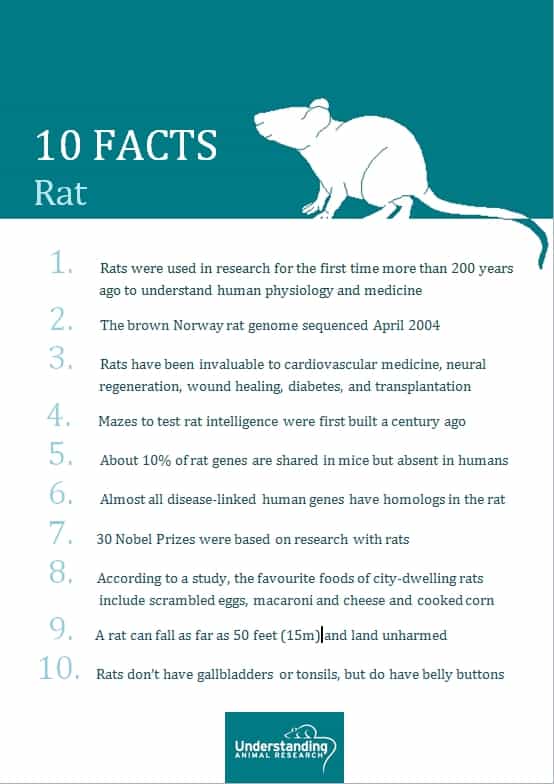
200 years ago, the brown rat, Rattus norvegicus, was first used by scientists to understand human physiology and medicine, with early studies concentrating on the effects of food and oxygen deprivation. Since then the rat has become almost a byword for laboratory experimentation. The first knockout and cloned rats were produced recently, and new techniques for creating transgenic rats were announced recently, allowing powerful models of human diseases to be developed.
http://www.animalresearch.info/en/designing-research/research-animals/rat/
2. The brown Norway rat genome is available since April 2004
The genome sequence of the Brown Norway rat was unveiled on 1 April 2004. The rodent's DNA was deciphered and analysed by a collaborative network of researchers, known as the Rat Genome Sequencing Project Consortium, led by the US Baylor College of Medicine. To achieve its goal of producing a high-quality draft sequence, the Consortium developed a new, "combined" approach that used both whole genome shotgun (WGS) and bacterial artificial chromosome (BAC) clone sequencing techniques. To merge these into the final draft sequence, they developed a software package for genome assembly.
The sequence is a high-quality draft of 2.75 billion bases that covers 90% of the genome. It is the third mammalian genome to be decoded, allowing three-way comparisons to be made with the human and mouse genomes.
http://www.animalresearch.info/en/designing-research/research-animals/rat/
http://www.animalresearch.info/en/designing-research/research-animals/rat/
http://www.animalresearch.info/en/designing-research/research-animals/rat-gm/
http://www.animalresearch.info/en/medical-advances/nobel-prizes/
4. Mazes to test rat intelligence were 1st built a century ago
Mazes to test rat intelligence were first built 100 years ago and the first albino Wistar rats were bred soon after. Since then the rat has become almost a byword for laboratory experimentation. The first knockout and cloned rats were produced recently, and new techniques for creating transgenic rats were announced last year, allowing powerful models of human diseases to be developed.
http://www.animalresearch.info/en/designing-research/research-animals/rat/
5. About 10% of rat genes are shared in mice but absent in humans
The rat genome is smaller than its human equivalent, but larger than that of the mouse. All three encode a similar number of genes - between 25,000 and 30,000. The new information should enable researchers to determine which characteristics are specific to rodents and which are shared by all mammals.
Around 10% of the rat's genes are both shared with the mouse and absent in humans, including some that code for olfactory proteins. This may explain rodents' exceptional sense of smell. Rats have more genes for breaking down toxins than man. This means that rats may be better at removing toxins from their bodies than humans, so it may be possible to refine the use of rats in toxicology. There are significant distinctions, also, in the genes of the immune system.
http://www.animalresearch.info/en/designing-research/research-animals/rat/
6. Almost all disease-linked human genes have homologs in the rat
Almost all disease-linked human genes have counterparts in the rat. Pinpointing these should help researchers to develop rat genetic models of human disease. Better rat models are likely to decrease drug failure in clinical trials - currently standing at about 90% - which will decrease development costs and time to market. The genome will also throw up new targets for drug intervention.
http://www.animalresearch.info/en/designing-research/research-animals/rat/
7. 30 Nobel Prize research used rats
http://www.animalresearch.info/en/medical-advances/nobel-prizes/
According to a study by Martin Schein, founder of the Animal Behavior Society, the favourite foods of city-dwelling brown rats include scrambled eggs, macaroni and cheese, and cooked corn.
http://www.animalbehaviorsociety.org/web/index.php
9. A rat can fall as far as 50 feet and land unharmed - in theory!
This is not a result found by live experiments, but by calculating the terminal velocity of an average rat at sea-level on Earth. Terminal velocity for animals is approximately 90 d0.5 m/s, where d is the diameter of the animal in meters. A human is about 0.3 m in diameter, while a mouse is about 0.03 m, so a mouse reaches terminal velocity at only about 15 m/s compared to a human's ~50 m/s. Smaller animals are also stronger compared to their body weight, because weight increases as the cube of size while strength increases as the square (approximately).
This paper explains the relation to size http://irl.cs.ucla.edu/papers/right-size.html
http://discovermagazine.com/2006/dec/20-things-rats
10. Rats don’t have gallbladders or tonsils, but do have belly buttons
http://discovermagazine.com/2006/dec/20-things-rats



